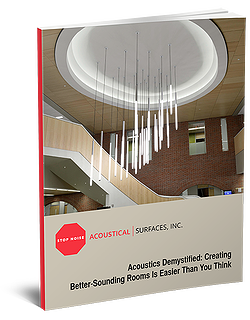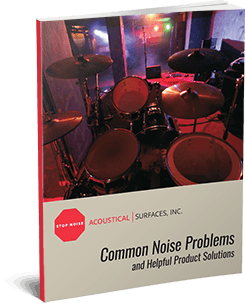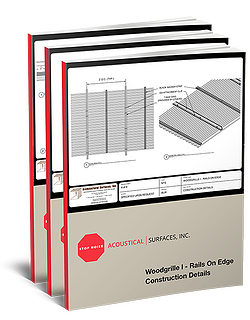How to Reduce Echo in an Office
Large offices are ideal for providing businesses with ample meeting spaces and building a stronger sense of community among coworkers. Unfortunately, more space can also lead to more echo.
Work in an office already comes with its own challenges to navigate. Added distractions, such as heightened noise and echo, can create big headaches for employees. In fact, noise-based distractions can negatively impact the mood and productivity of an office, which can in turn put a strain on the entire business.
Fortunately, we have all the information and products you need to create a quiet, pleasant, and productive workplace environment.
The Science Behind an Echo
To learn how to reduce echo in the office, it’s helpful to first understand how echoes are created.
Sound waves occur when air is disturbed; the air moves rapidly back and forth until it reaches our ears which translates the air vibrations into sounds we can hear.1 Similar to light, these sound waves can bounce off of surfaces and create additional sounds—what we call an echo.1
Particularly flat, solid surfaces, like walls, are perfect for bouncing the sound wave and creating echoes. But why does it echo in your office and not in the bathroom? Put simply, the more space a sound has to travel, the louder and clearer the echo will be.1
This is why large offices—especially those with open floor plans or high ceilings—have such an issue with noise and echoes.
Simple and Effective Solutions to Reduce Echo
So, how can you reduce echo in office spaces to minimize noise distractions and promote productivity? The key is to use specially designed materials that absorb sound, as well as materials that block or reduce sound.
Door Seals for Noise Reduction
Since sound waves travel through the air, they can fit through the tiniest spaces, like the gaps surrounding a door. To prevent outside sounds from traveling into your office, you’d need to fill those gaps. This is exactly what a door seal does.
In fact, our Adjustable Acoustic Door Seals provide an economical solution to reducing noise between office spaces
Door seals work to fill the gaps found between a door and its surrounding walls, stopping sound from entering or escaping a space. Our door seal kits are conveniently designed to fit on any sized door—we also carry both regular and heavy-duty kits to suit your specific noise reduction needs.
Fabric Wrapped Panels for Sound Absorption
Sound-absorbing materials do exactly what you think they do. These soft, porous fabrics absorb the sound waves in a space in order to:
- Improve sound quality
- Reduce echo
Remember that an echo is created when sound waves bounce off a hard surface; if these surfaces are covered in soft materials, such as polyester, the sound is unable to bounce.
For a subtle way to add sound absorption into your existing office design, check out Acoustical Surfaces’ Poly Max acoustical wall panels and ceiling panels. The fabric-wrapped wall panels and industrial acoustic panels provide high-quality sound absorption, and they also come in a variety of colors so that you can easily match your office’s interior.
Floor Underlayments: An Underestimated Solution
When it comes to reducing echo and unwanted sound, most people focus on adding materials to doors and walls. However, acoustic treatment for your floors may be the hidden solution you’ve been looking for.
Sound can bounce just as easily off of floors as it can off of walls and ceilings. Similar to the function of fabric-wrapped ceiling panels and wall panels, soundproof floor underlayment create a softer surface layer that absorbs sound and prevents echoes.
Acoustical Surfaces offers an effective and discreet floor underlay option: the ACOUSTIK Sound Deadening Floor Underlay. You won’t be able to see it, but you’ll be sure to hear a difference as the material reduces room echo and prevents sound from lower floors from entering your space.
Made from recycled rubber, the ACOUSTIK underlay is also a greener echo reduction option.
Advanced Soundproofing Techniques
If you want to take your office soundproofing to the next level, consider options that not only reduce background noise in shared office spaces, but also individual ones as well. They can be used between cubicles and even on desks to make close-quarter office spaces quiet and distraction-free.
Soundproofing for Modern Offices
A contemporary improvement to the traditional office design is the soundproof pod—a quiet and intimate space for colleagues to meet and work together. The keyword here is “soundproof.”
To promote the most productivity with this type of office design, we suggest implementing our Silk Metal and Sound Silencer panels. Both products are easy to install and offer a clean, stylish look that meshes nicely with the theme of any space.
Acoustical Surfaces: Your Expert in Echo Reduction
If you have an echo problem in your office space, you can rest assured that there are many effective noise reduction options available to you—and the experts at Acoustical Surfaces are here to help you find the right ones.
With our high-quality products and expertise, you can reduce distracting echoes, enhance productivity, and create a pleasant office environment for you and your employees.
Explore all of our soundproofing and sound-absorbing acoustic panels or treatment options.
You can also contact us directly to discuss your sound reduction needs.
Sources:
- The Conversation. Curious Kids: What Makes an Echo? https://theconversation.com/curious-kids-what-makes-an-echo-109141




